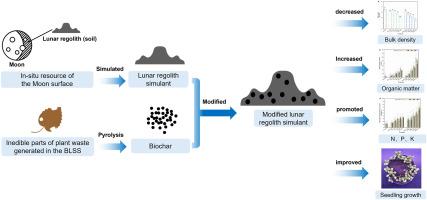Biochar derived from plant waste improves seedling growth by influencing the physical structure and nutrient content of simulated lunar soil
IF 3.4
2区 物理与天体物理
Q1 ENGINEERING, AEROSPACE
引用次数: 0
Abstract
The utilization of native lunar soil and recycled organic waste as primary resources can effectively reduce reliance on terrestrial inputs and improve the self-sufficiency of bioregenerative life support system for future lunar bases. However, lunar soil differs considerably from Earth's soil as it lacks organic carbon and the associated nutrients necessary for plant growth. To address these challenges, biochar can be produced by recycling the organic waste generated in a BLSS. As an environmentally friendly amendment, biochar can enhance the structure and nutrient content of soil and promote plant growth. Therefore, the purpose of this study is to investigate the suitability of native lunar soil for plant growth and assess how its agronomic performance is affected by the addition of biochar derived from plant waste. Compared with the control treatment, rice straw biochar treatment significantly improved the physical and chemical properties of the lunar soil simulant (p < 0.05), increasing the organic matter content by 91.02 % and enhancing N availability by 69.68 %, P availability by 82.83 %, and K availability by 21.60 %. Redundancy analysis suggested that soil air porosity, total P, and available K, were critical factors influencing lettuce growth. The optimal amount of biochar to amend simulated lunar soil should be set at 3 %. The experimental findings demonstrated that the addition of biochar to the simulated lunar soil had positive effects on its chemical and physical properties, as well as its potential for supporting plant growth.

从植物废弃物中提取的生物炭通过影响模拟月球土壤的物理结构和养分含量来促进幼苗生长
利用月球原生土壤和再生有机废弃物作为主要资源,可以有效减少对陆地投入的依赖,提高未来月球基地生物再生生命维持系统的自给能力。然而,月球土壤与地球土壤有很大不同,因为月球土壤缺乏有机碳和植物生长所必需的相关营养物质。为了应对这些挑战,生物炭可以通过回收BLSS中产生的有机废物来生产。生物炭作为一种环保型改良剂,可以增强土壤结构和养分含量,促进植物生长。因此,本研究的目的是研究天然月球土壤对植物生长的适宜性,并评估添加植物废弃物生物炭对其农艺性能的影响。与对照处理相比,秸秆生物炭处理显著改善了模拟月壤的理化性质(p < 0.05),有机质含量提高了91.02%,氮有效性提高了69.68%,磷有效性提高了82.83%,钾有效性提高了21.60%。冗余分析表明,土壤孔隙度、全磷和速效钾是影响生菜生长的关键因素。模拟月球土壤中生物炭的最佳添加量为3%。实验结果表明,在模拟月球土壤中添加生物炭对其化学和物理性质以及支持植物生长的潜力具有积极影响。
本文章由计算机程序翻译,如有差异,请以英文原文为准。
求助全文
约1分钟内获得全文
求助全文
来源期刊

Acta Astronautica
工程技术-工程:宇航
CiteScore
7.20
自引率
22.90%
发文量
599
审稿时长
53 days
期刊介绍:
Acta Astronautica is sponsored by the International Academy of Astronautics. Content is based on original contributions in all fields of basic, engineering, life and social space sciences and of space technology related to:
The peaceful scientific exploration of space,
Its exploitation for human welfare and progress,
Conception, design, development and operation of space-borne and Earth-based systems,
In addition to regular issues, the journal publishes selected proceedings of the annual International Astronautical Congress (IAC), transactions of the IAA and special issues on topics of current interest, such as microgravity, space station technology, geostationary orbits, and space economics. Other subject areas include satellite technology, space transportation and communications, space energy, power and propulsion, astrodynamics, extraterrestrial intelligence and Earth observations.
 求助内容:
求助内容: 应助结果提醒方式:
应助结果提醒方式:


